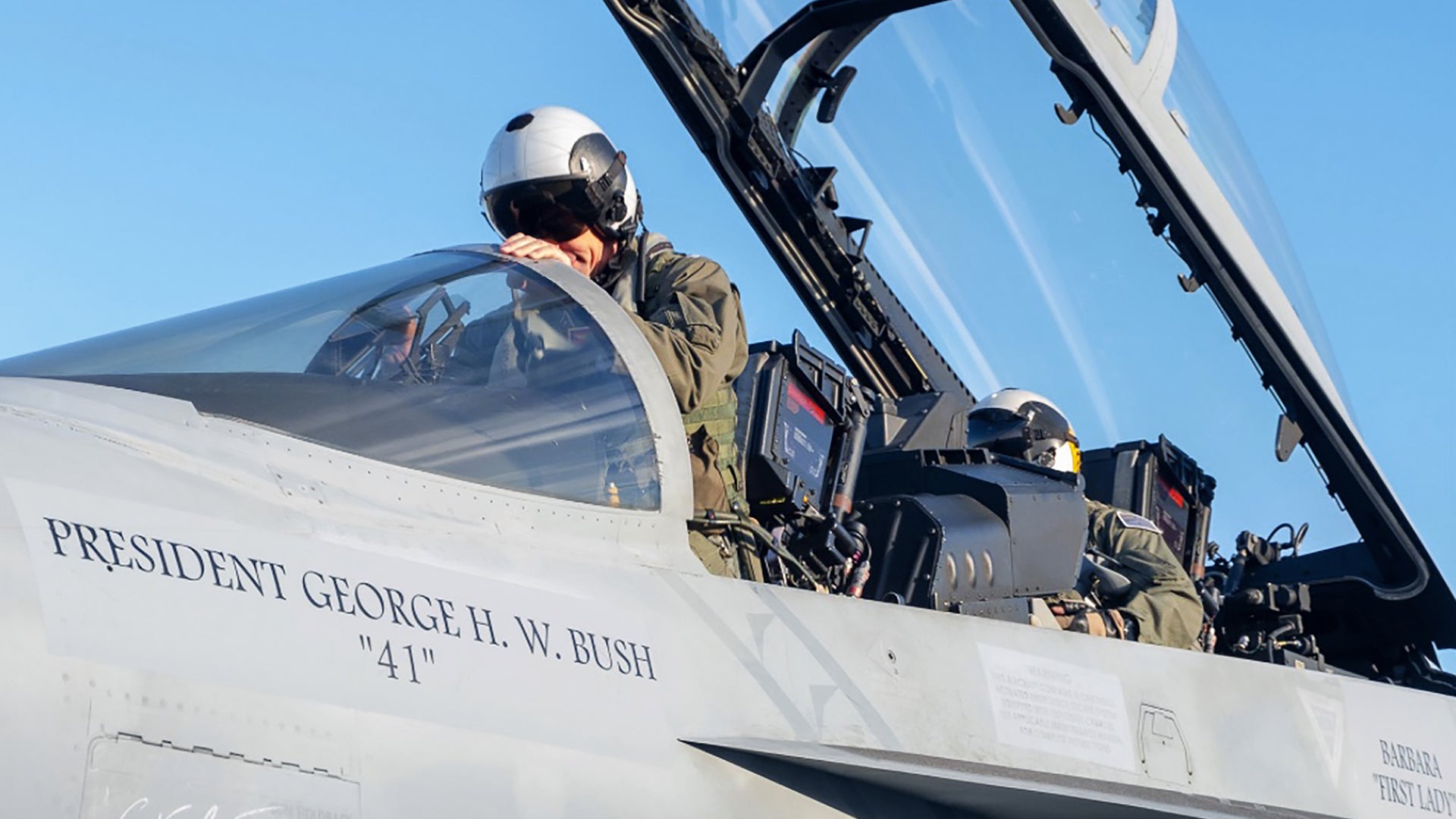Navy Strike Fighter Squadron VFA-103, the famous “Jolly Rogers,” will lead a huge formation of 21 jets over College Station, Texas where the George H.W. Bush library is located, to pay tribute to the legendary Naval Aviator and 41st President of the United States. Bush will be laid to rest next to First Lady Barbara Bush on the library’s grounds on Thursday at the culmination of the memorial services.
The F/A-18F that will lead the formation has “President George H.W. Bush “41”” scrawled below the front seat’s windscreen and “Barbara “First Lady”” below the back seat canopy rail—a fitting tribute to one of the most famous Navy flyers of all time.

The Jolly Rogers, which are based at NAS Oceana in Norfolk, Virginia, have their iconic skull and crossbones mascot that is deeply ingrained in the unit’s history and lore. This symbolism is also fitting as Bush’s time as a Bonesman at Yale greatly influenced him, but not as much as the time he spent fighting the Japanese in TBF Avenger torpedo bombers over the Pacific during World War II.
Six months after the Japanese bombed Pearl Harbor, and on his 18th birthday, George joined the war effort and became the youngest naval aviator ever. Bush, with the callsign “Skin” due to his lanky frame, flew with VT-51 aboard the light aircraft carrier USS San Jacinto (CVL-30) during many battles at the height of the war.
During a mission on June 19th, 1944, San Jacinto and its task force trounced the Japanese during the battle that is now called the Great Marianas Turkey Shoot. Ensign Bush was returning to the carrier when his aircraft experienced mechanical trouble and he and his crew were forced to make a perilous water landing. The destroyer USS Clarence K. Bronson ended up rescuing Bush and his crew and they were returned to their air wing after the harrowing ordeal.

But it was on September 2nd, 1944, when a fateful mission would change the future President’s life forever and the course of American history. Bush and his two crew, Radioman Second Class John Delaney and Lieutenant (JG) William White, were on a bombing raid that targeted highly defended Japanese positions on Chichi Jima, a tiny island 700 miles west of Japan, when their Avenger was blasted with flak. Bush still successfully struck his target with his bomb load and kept flying the plane as long as possible to separate him and his crew from the Japanese below. After telling his crew to bail out, Bush also jumped from the burning aircraft, smashing his forehead on the Avenger’s tail in the process.
Bush climbed into his tiny survival raft as American fighters circled overhead and beat back Japanese boats that were trying to capture him. Once secure in his raft, he realized his squadronmates didn’t make it to the surface alive. While other crews that were shot down during the raid were captured, tortured, executed, and even eaten, by chance Bush was saved hours after hitting the water by the crew of the submarine USS Finback that was lurking in the area.
Video of the moment a frazzled Bush climbed to safety aboard the submarine became one of the most historic pieces of footage from the Pacific theater. Bush stayed aboard the submarine for weeks assisting with rescues of other aircrews that were otherwise left to die in the lonely and unforgiving waters of vast Pacific.

This ordeal changed Bush dramatically and he was haunted by questions as to why he had survived by his brothers in arms hadn’t his entire life. But those questions also helped shape his dedication to service and his kindness towards others throughout his illustrious public service career and eventually as the head of a large and influential family.
Listen to the 41st President describe the events of that day in his own words below:


In total, Lieutenant George H.W. Bush went on 58 combat missions and was highly decorated for his service, receiving the Distinguished Flying Cross and three Air Medals. The Presidential Unit Citation was also awarded USS
San Jacinto for the carrier’s incredible actions during the war. Naval Aviator George H.W. Bush went on to be an instructor in Norfolk and stood up a new squadron before being discharged once the war drew to a close.
Amazingly, this was just the start of what would become one of the most impressive public service careers in American history.
So yeah, if anyone deserves a 21 fighter flyover and his name on Super Hornet it’s Lieutenant turned Command In Chief George H.W. Bush.
The flyover will occur at 4:15pm at the George H.W. Bush Presidential Library.
Contact the author: Tyler@thedrive.com
